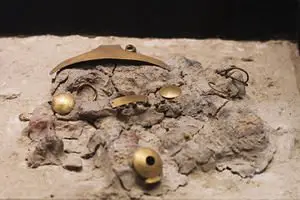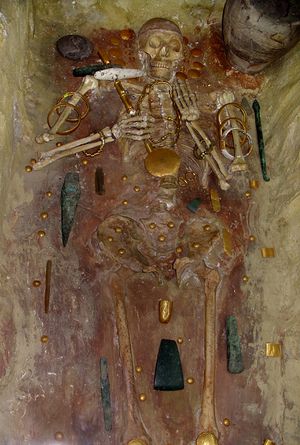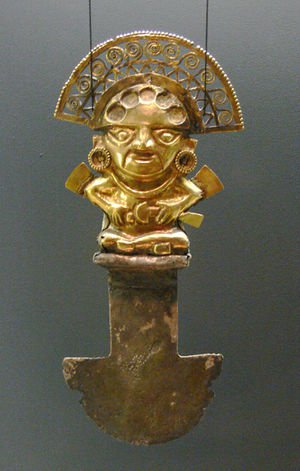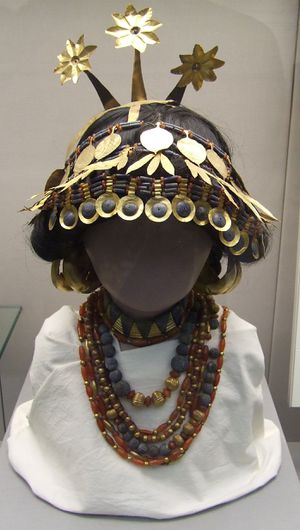Difference between revisions of "How Did Gold Become Desired by Ancient Civilizations"
(→Conclusion) |
(→Early Use of Gold) |
||
| Line 9: | Line 9: | ||
[[File:Or de Varna - Nécropole.jpg|thumbnail|right|Figure 2. A burial of a high status individual at Varna Necropolis; this individual stands out from among the graves and seems to have a substantial amount of gold compared to other graves.]] | [[File:Or de Varna - Nécropole.jpg|thumbnail|right|Figure 2. A burial of a high status individual at Varna Necropolis; this individual stands out from among the graves and seems to have a substantial amount of gold compared to other graves.]] | ||
| − | |||
| − | In the southern Levant, a cave in the area of Nahal Qanah contained eight artifacts from a burial context that suggests a type of elite burial ground could have been established by the 4th millennium BC. In fact, the find suggests gold could have already become the privy of the most elite in society | + | In the southern Levant, a cave in the area of Nahal Qanah contained eight artifacts from a burial context that suggests a type of elite burial ground could have been established by the 4th millennium BC. These gold objects were in the form of gold rings. In fact, the find suggests gold could have already become the privy of the most elite in society. <ref>For more information about the Nahal Qanah cave, see: Gopher, Avi, Tseviḳah Tsuḳ, and I. Carmi. 1996. The Naḥal Qanah Cave: Earliest Gold in the Southern Levant. Monograph Series / Tel Aviv University, Sonia and Marco Nadler Institute of Archaeology, no. 12. Tel Aviv: Institute of Archaeology of Tel Aviv University Publications Section.</ref> What the finds at Nahal Qanah and Varna Necropolis show is that early from gold's history it had already become an object that differentiated wealth and status in societies. However, the finds in the south Levant showed that gold was even more restricted, perhaps to the most elite members of society. In both cases, gold was found in the form of body jewellery, showing that its early development led to it becoming associated as a body adornment. <ref>For more information on the analysis of the Nahal Qanah finds, see: Shalev, Sariel. 1995. “Metals in Ancient Israel: Archaeological Interperetation of Chemical Analysis.” Israel Journal of Chemistry 35 (2): 109–16.</ref> |
In Egypt and Mesopotamia, the two main regions where early urban cultures developed, gold was used by the 5th millennium BC. In Egypt, significant mining was likely already taking place in areas where gold deposits were commonly found, mainly in areas of southern Egypt and Nubia. <ref>For more information about gold mining and gold in Egypt, see: Klemm, Rosemarie, and Dietrich Klemm. 2013. Gold and Gold Mining in Ancient Egypt and Nubia: Geoarchaeology of the Ancient Gold Mining Sites in the Egyptian and Sudanese Eastern Deserts. 2012. New York: Springer.</ref> In Mesopotamia, the first gold appears in the 5th millennium BC during the Ubaid period. We begin to get references to gold in texts by the 3rd millennium BC, showing it becoming an important object for imports. However, in many cases, where gold has been discovered, it was found as an alloy with silver (i.e., electrum). At times, gold was also alloyed with lead, indicating that pure gold was generally more rare.<ref>For more information about gold in Mesopotamia, see: Leick, Gwendolyn. 2010. Historical Dictionary of Mesopotamia. 2nd ed. Historical Dictionaries of Ancient Civilizations and Historical Eras, no. 26. Lanham: Scarecrow Press, pg. 79. | In Egypt and Mesopotamia, the two main regions where early urban cultures developed, gold was used by the 5th millennium BC. In Egypt, significant mining was likely already taking place in areas where gold deposits were commonly found, mainly in areas of southern Egypt and Nubia. <ref>For more information about gold mining and gold in Egypt, see: Klemm, Rosemarie, and Dietrich Klemm. 2013. Gold and Gold Mining in Ancient Egypt and Nubia: Geoarchaeology of the Ancient Gold Mining Sites in the Egyptian and Sudanese Eastern Deserts. 2012. New York: Springer.</ref> In Mesopotamia, the first gold appears in the 5th millennium BC during the Ubaid period. We begin to get references to gold in texts by the 3rd millennium BC, showing it becoming an important object for imports. However, in many cases, where gold has been discovered, it was found as an alloy with silver (i.e., electrum). At times, gold was also alloyed with lead, indicating that pure gold was generally more rare.<ref>For more information about gold in Mesopotamia, see: Leick, Gwendolyn. 2010. Historical Dictionary of Mesopotamia. 2nd ed. Historical Dictionaries of Ancient Civilizations and Historical Eras, no. 26. Lanham: Scarecrow Press, pg. 79. | ||
Revision as of 19:55, 24 April 2016
Contents
Early Use of Gold
One of the oldest known uses of gold appears to be in Bulgaria, from a site that is called Varna Necropolis or Varna Cemetery, which dates to around 4600 BC.[1] The site is a burial ground were a number of gold artifacts were found to be in burial contexts associated with a variety of individuals. Surprisingly, out of the more than 200 graves found, many of them contained gold and other metal finds (primarily copper; Figure 1). This indicates a society that had already developed a strong affinity toward gold and it became a status object for many members of society. However, we also begin to see that not all individuals were treated equally. One individual seemed to have far more gold buried with him, with objects including a gold mace, jewelry, and even a penis sheath made of gold (Figure 2). This could indicate that this society had begun to develop a type of chiefdom society, where one individual did accumulate more power than others and consequently have more gold than the other graves.
In the southern Levant, a cave in the area of Nahal Qanah contained eight artifacts from a burial context that suggests a type of elite burial ground could have been established by the 4th millennium BC. These gold objects were in the form of gold rings. In fact, the find suggests gold could have already become the privy of the most elite in society. [2] What the finds at Nahal Qanah and Varna Necropolis show is that early from gold's history it had already become an object that differentiated wealth and status in societies. However, the finds in the south Levant showed that gold was even more restricted, perhaps to the most elite members of society. In both cases, gold was found in the form of body jewellery, showing that its early development led to it becoming associated as a body adornment. [3]
In Egypt and Mesopotamia, the two main regions where early urban cultures developed, gold was used by the 5th millennium BC. In Egypt, significant mining was likely already taking place in areas where gold deposits were commonly found, mainly in areas of southern Egypt and Nubia. [4] In Mesopotamia, the first gold appears in the 5th millennium BC during the Ubaid period. We begin to get references to gold in texts by the 3rd millennium BC, showing it becoming an important object for imports. However, in many cases, where gold has been discovered, it was found as an alloy with silver (i.e., electrum). At times, gold was also alloyed with lead, indicating that pure gold was generally more rare.[5]
By the early 3rd millennium BC, gold becomes symbolic with royal authority in Egypt. Expeditions were now organized for mines containing gold. [6] In the Indus, by the 3rd millennium BC, and likely earlier, gold was also utilized extensively, reflecting its increased importance for elites and trade. Similar to other regions, gold was generally found as part of electrum, which is also a natural alloy. [7]
In the New World, the region of the Andes, in Peru specifically, has the earliest dated gold finds, where objects date to around 2000 BC. Interestingly, these early gold finds are in the form of jewelry and found in burial context, similar to the Old World discoveries. [8] This could suggest, similar to other regions, that as social hierarchy and stratification became established, gold was one object that differentiated the status of humans within society. In other words, gold becomes associated with wealth and power soon after it begins to be used (Figure 3).
Role in Society
In the cases where gold was found at relatively early dates, several characteristics are evident. For one, gold is often found in funerary contexts, suggesting it was both a status symbol in life but also something to be taken to the next life. Interestingly, in many of the finds from the Old and New World indicate that gold, despite its rarity, was from its onset a way to display power in the afterlife and as a way to remind others of the power and prestige of the individual to members of society after they had passed away. [9] This concept continues when we see the development of state societies. Kingship, and by extension the state, begin to utilize gold more frequently for burials and in many of these cases it was a way to display power in the present and afterlife.
Perhaps this reflects the next life or afterlife similarly is characterized by social stratification. In fact, as social hierarchy developed in ancient societies, which seems to be true both in the New and Old Worlds, gold was common among societies that differentiated individuals in power and prestige. This is evident in finds from Peru, Bulgaria, Egypt, southern Levant, and Mesopotamia.
Nevertheless, there are key differences with how gold was treated in early societies. In the ancient Near East, gold was often found as jewelry with women, suggesting women often wore gold as representing family wealth or were often the ones who literally wore the family's wealth. [10] This could be one reason we find female burials often have large quantities of gold. For example, the burial of the Queen or Priestess of Puabi from the ancient city of Ur is one example of this (Figure 4).
It is also by the 3rd millennium BC that we begin to see gold having more of a trade value, although very likely this occurred earlier. We see evidence of gold being shipped in from distant regions, such as India or Anatolia, in places such as Mesopotamia. In the 2nd millennium BC, when the trade in gold became more substantial in the eastern Mediterranean region, it is during this active time of trade that gold becomes also a standard used to measure value of other commodities. Between 1600-1200 BC, the Late Bronze Age saw gold becoming the basis of value for many valuable objects now being traded between Central Asia and the Mediterranean, including metals such as tin and copper. [11] However, this was a relatively exceptional period, as in most other Bronze Age periods silver was considered the more common standard, given its greater prevalence. [12]
Evolution of Gold
During the 1st millennium BC, by around the 6th century BC in the Near East and eastern Mediterranean Hellenistic states, we begin to see coins now utilized with gold.[13] In fact, it is one of the first metals to be fashioned into coins, suggesting gold coins and coins i general were first intended for high value exchange. While this largely reflects gold’s role as an object utilized for trade and exchange, it now also shows royal authority was beginning to stamp gold with iconography as a way to show government-level backing. This derives from the concept of gold and royalty we had seen in the third millennium BC graves and other royal or high elite status. In effect, coinage and gold become established as the privy of the state [14]
Eventually, as gold coins continue to be utilized, the use of gold and how much gold in coins becomes standardized more substantially. The concept accelerates in the late 1st millennium BC across the Mediterranean world, where gold is always the top-level currency and can only be minted by the governments controlling a given region. This concept of gold currency continues into the Medieval world, in particular for Europe after the reemergence of states.[15]. Arguably, one of the chief motivations for the Spanish conquests in the New World was gold and much of that became refashioned into gold-level currency used by the governing bodies and banks of Spain after their conquest. This helped launch Spain and other European powers eventually into a global race not only for power but one can argue a race to accrue as much gold as possible, as it symbolized the new power of Europe.
What the example shows is that gold had, very early, established itself as a metal distinct from all other metals. It quickly became a prestige good that changed media, such as in coinage, but the prestige continued irrespective of the media and into the modern era.
Conclusion
Gold can be seen to be something of great desire in many societies in the New and Old worlds (the Americas, Asia, and Africa). Despite the diversity of the location of where gold was first found, at the onset gold was seen as a way to differentiate the power of individuals, in this life and the afterlife. This suggests the qualities of gold as being attractive to human societies seems almost universal or innate. Gold utilization in societies evolves over time as a basis for economies. By the time currency or coins are used, gold becomes a high level standard that royal authority can only support and uses as a basis in economic exchange by placing the image of the king on currency. This begins to make gold as something to be controlled by state societies and their primary privy rather than that of common individuals. With the control of gold by governments, this begins to help standardize its value and this concept continues into the modern era, while gold’s value and importance to society has only increased since ancient periods.
References
- ↑ For detailed information about the Varna Necropolis, see: Ivanov, Ivan Simeonov, and Mai︠a︡ Avramova, eds. 2000. Varna Necropolis: The Dawn of European Civilization. Treasures of Bulgaria 1. Sofia: Agatʹo Publ.
- ↑ For more information about the Nahal Qanah cave, see: Gopher, Avi, Tseviḳah Tsuḳ, and I. Carmi. 1996. The Naḥal Qanah Cave: Earliest Gold in the Southern Levant. Monograph Series / Tel Aviv University, Sonia and Marco Nadler Institute of Archaeology, no. 12. Tel Aviv: Institute of Archaeology of Tel Aviv University Publications Section.
- ↑ For more information on the analysis of the Nahal Qanah finds, see: Shalev, Sariel. 1995. “Metals in Ancient Israel: Archaeological Interperetation of Chemical Analysis.” Israel Journal of Chemistry 35 (2): 109–16.
- ↑ For more information about gold mining and gold in Egypt, see: Klemm, Rosemarie, and Dietrich Klemm. 2013. Gold and Gold Mining in Ancient Egypt and Nubia: Geoarchaeology of the Ancient Gold Mining Sites in the Egyptian and Sudanese Eastern Deserts. 2012. New York: Springer.
- ↑ For more information about gold in Mesopotamia, see: Leick, Gwendolyn. 2010. Historical Dictionary of Mesopotamia. 2nd ed. Historical Dictionaries of Ancient Civilizations and Historical Eras, no. 26. Lanham: Scarecrow Press, pg. 79.
- ↑ For more information about gold expeditions, see: Der Manuelian, Peter, and Thomas Schneider, eds. 2015. Towards a New History for the Egyptian Old Kingdom: Perspectives on the Pyramid Age. Harvard Egyptological Studies, volume 1. Leiden ; Boston: Brill, pg. 445.
- ↑ For more information about gold in the Indus, see: McIntosh, Jane. 2008. The Ancient Indus Valley: New Perspectives. ABC-CLIO’s Understanding Ancient Civilizations Series. Santa Barbara, Calif: ABC-CLIO, pg. 145.
- ↑ For more information about the earliest gold artefacts from Peru, see: Aldenderfer, M., N. M. Craig, R. J. Speakman, and R. Popelka-Filcoff. 2008. “Four-Thousand-Year-Old Gold Artifacts from the Lake Titicaca Basin, Southern Peru.” Proceedings of the National Academy of Sciences 105 (13): 5002–5. doi:10.1073/pnas.0710937105.
- ↑ Boyle, Robert W. 1987. Gold History and Genesis of Deposits. Boston, MA: Springer US. http://dx.doi.org/10.1007/978-1-4613-1969-6.
- ↑ For further information on women in ancient Near East society and wealth, see: Chavalas, Mark W., ed. 2012. Women in the Ancient Near East: A Sourcebook. Routledge Sourcebooks for the Ancient World. London: Routledge.
- ↑ For more information on the Late Bronze Age gold standard, see: Edwards, Iorwerth Eiddon Stephen, ed. 2003. History of the Middle East and the Aegean Region C. 1380 - 1000 B.C. 3. ed., 6. printing. The Cambridge Ancient History, Vol. 2, Pt. 2. Cambridge: Cambridge Univ. Press.
- ↑ For a history of gold and its role in ancient societies, see: Bernstein, Peter L. 2004. The Power of Gold: The History of an Obsession. Illustrated ed. New York: Wiley.
- ↑ For more on the evolution of early coins and gold coins, see: Leslie Kurke. 1999. Coins, Bodies, Games and Gold. The Politics of Meaning in Archaic Greece. Princeton: Princeton University Press.
- ↑ For a history and presentation of types of ancient gold coins, see Friedberg, Arthur L., Ira S. Friedberg, and Robert Friedberg. 2003. Gold Coins of the World: From Ancient Times to the Present: An Illustrated Standard Catalogue with Valuations. 7th ed. Clifton, N.J: Coin and Currency Institute.
- ↑ For example of gold and how it was used for currency in the Medieval World, see: Allen, Martin. 2012. Mints and Money in Medieval England. Cambridge: Cambridge University Press.
Maltaweel, Admin, Kestrel10 and EricLambrecht



